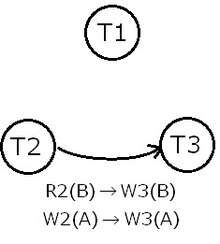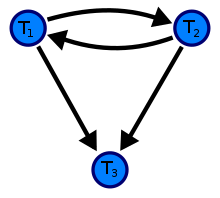Precedence graph
A precedence graph, also named conflict graph and serializability graph, is used in the context of concurrency control in databases.
The precedence graph for a schedule S contains:
- A node for each committed transaction in S
- An arc from Ti to Tj if an action of Ti precedes and conflicts with one of Tj's actions.
Precedence graph examples
Example 1

Example 2
Example 2
A precedence graph of the schedule D, with 3 transactions. As there is a cycle (of length 2; with two edges) through the committed transactions T1 and T2, this schedule (history) is not Conflict serializable. Notice, that the commit of Transaction 2 does not have any meaning regarding the creation of a precedence graph.
Testing Serializability with Precedence Graph

Testing Serializability Example
Algorithm to test Conflict Serializability of a Schedule S along with an example schedule.
- or
- For each transaction Tx participating in schedule S, create a node labeled Ti in the precedence graph. Thus the precedence graph contains T1, T2, T3.
- For each case in S where Tj executes a read_item(X) after Ti executes a write_item(X), create an edge (Ti → Tj) in the precedence graph. This occurs nowhere in the above example, as there is no read after write.
- For each case in S where Tj executes a write_item(X) after Ti executes a read_item(X), create an edge (Ti → Tj) in the precedence graph. This results in a directed edge from T1 to T2 (as T1 has R(A) before T2 having W(A)).
- For each case in S where Tj executes a write_item(X) after Ti executes a write_item(X), create an edge (Ti → Tj) in the precedence graph. This results in directed edges from T2 to T1, T2 to T3 and T1 to T3.
- The schedule S is serializable if and only if the precedence graph has no cycles. As T1 and T2 constitute a cycle, the above example is not (conflict) serializable.
gollark: Install blood magic?
gollark: I do have problems with it *other* than it overshadowing everything else, so adding more similar mods is not a great idea.
gollark: .
gollark: Avaritia is just the most ridiculous big-number thing around, nothing else comes close as far as I know
gollark: *Are* there any?
External links
- The Fundamentals of Database Systems, 5th Edition the use of precedence graphs is discussed in chapter 17, as they relate to tests for conflict serializability.
- Abraham Silberschatz, Henry Korth, and S. Sudarshan. 2005. Database Systems Concepts (5 ed.), PP. 628–630. McGraw-Hill, Inc., New York, NY, USA.
This article is issued from Wikipedia. The text is licensed under Creative Commons - Attribution - Sharealike. Additional terms may apply for the media files.